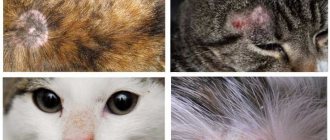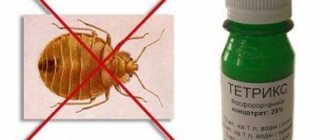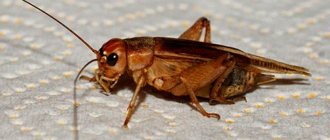A cat is one of the cleanest animals; it can lick its fur for hours, putting it in order. She does not change her habit either after eating and sleeping, or after visiting the toilet and petting her owners. But sometimes pet owners begin to notice that the cat is more habitually engaged in grooming than usual, and the habit of licking turns into manic obsession. Now all the time, outside of sleeping and eating, the cat constantly licks its fur. This behavior of the animal not only can, but should alert the owner.
Why does a cat constantly lick its tail?
The owners of tailed purrs notice this pathological habit immediately, because it can be terribly annoying, especially if the pet does it near people and even on their bed. You shouldn’t just drive the animal away, as there are many reasons for this behavior. Moreover, they all require contacting a veterinarian. A cat can lick its tail for hours due to:
- allergic reaction to certain foods;
- the presence of parasites in the body (with this disease, the cat will not lick the fur, but directly the anal entrance);
- skin damage on the tail.
A symptom such as licking under the tail often indicates that the pet is under stress. Stress can be caused by the fact that the house has another pet or is undergoing renovations. Constant licking has a calming effect on your furry pet.
Reasons why your pet licks itself often
Frequent licking of the entire body may be directly related to the disease. Why a cat licks his lips has its own reason in various ailments. The question is how to recognize, and what to do, and what help to provide to the pet.
Causes:
- change of feed or expired food. Low-quality components can cause allergic reactions in cats. They are accompanied by itching, various manifestations of dermatitis, swelling of the eyes and nose, and lacrimation. In this case, it is necessary to give the cat complete rest, drink plenty of fluids and take him to a veterinary clinic, or call a doctor at home;
- Tailed pets who have reached the age of 5 years may experience dental diseases. At the same time, they salivate copiously and have to swallow it. Also, the gums bleed, there is a putrid odor from the mouth, the animal refuses to eat and is lethargic all the time;
- oxidation of saliva in cats occurs from dysbiosis, gastritis and heartburn. Licking only momentarily prevents symptoms from appearing, but the more she licks, the more pronounced the symptoms become. The cat may sleep all day and becomes weak;
- the presence of a foreign object in the oral cavity. It happens that a small object gets stuck between the teeth, or in the mucous membrane of the oral cavity, and this brings a lot of discomfort. The body secretes a lot of saliva to solve this problem, but only with the help of a person can you get rid of the splinter. Its presence is accompanied by the fact that the cat licks its lips and constantly smacks its lips, it vomits and completely loses its appetite;
- ingestion of a foreign body. Prompt medical attention is needed here. An object that cannot come out naturally becomes a huge threat to the pet’s life;
- poisoning. Intense secretion of saliva is also characteristic of intoxication of the body with any substances. A poisoned mouse, not fresh food, exposure to chemical vapors - all these are causes of poisoning, which are accompanied by vomiting, diarrhea, nausea, restlessness of the pet, and a decrease in body temperature. There may be blood in the stool, the mucous membrane of the eyes turns pale, and in severe cases, convulsions and loss of consciousness;
- pathologies of the digestive system;
- disturbances in the functioning of the kidneys and urogenital bladder.
In any case, constant licking means that a visit to the veterinarian is necessary to get an answer, find out the reason for the pet’s behavior, and provide him with the necessary help.
Why does a cat lick its fur in different places, but the animal has no fleas?
The presence of fleas in a pet is the first thing a cat owner thinks about if he notices that he is constantly licking his fur. Even if a quick examination did not reveal parasites in the fur, this does not mean that they are not there. Nits are not so clearly visible; they look like black, very small dots on the skin between the hairs.
However, the cause of constant licking of fur can be not only fleas, but also other skin parasites - scabies mites. It is quite easy to identify them by such signs as the presence of lesions on the skin in the area of the ankles, ears and elbows.
If a cat licks its fur mainly in the summer, but does not have fleas or parasites, there is a possibility that the pet has increased sensitivity to insect bites, such as mosquitoes.
Constant licking of a cat's fur in the absence of parasites may be an initial sign of one of the pathological conditions:
- depriving;
- dermatitis;
- endocrine system disorders;
- otitis;
- skin diseases - demodicosis, pyodermatitis.
All these pathologies, in addition to constant licking, are accompanied by other symptoms - the presence of wounds and erosions on the surface of the skin, areas of severe peeling.
Signs of lichen and fungal infections
Infection of the skin with lichen forces cats to clean their toilets more carefully than usual. If the owner notices that his pet has begun to lick its fur most of the time, you need to carefully examine its skin. If there is lichen on the skin, pockets of erosion or scabs will be visible between the hairs.
With fungus everything is much more complicated.
It is impossible to determine the presence of a fungal infection without examination by a veterinarian and instrumental examination using special equipment.
But there are a number of signs that an attentive owner will notice:
- excessive dry skin;
- the skin in certain areas changes its color, becomes paler or, conversely, stands out excessively, becoming darker or brighter by several tones;
- the appearance of gray scales that separate from the skin;
- the fur becomes thinner.
Similar signs may be present in other skin diseases, so it is not possible to make a diagnosis without a veterinarian.
Dermatitis
Identifying dermatitis in a cat is no less difficult a task than diagnosing a fungal infection. A cat will constantly lick its fur because it suffers from an incessant feeling of itching and burning. One of the most pronounced signs of dermatitis is the presence of inflammatory processes on the skin.
It is almost impossible to determine the presence of dermatitis at an early stage of its development, therefore, if the owner notices that his cat has clearly begun to lick itself longer and more often, it should be immediately shown to a veterinarian.
Otitis
An ear infection is always accompanied by severe itching. The cat will lick itself vigorously, damage its face and ears with its claws, and constantly shake its head. Other signs include redness of the inside of the ear, swelling and pus discharge.
Development of skin diseases
Demodecosis and pyodermitis are pathologies of the skin that are accompanied by severe and constant itching, while the cat experiences severe, ongoing discomfort. Due to the incessant “mange”, the cat begins to lick its fur and sometimes does it so intensely that bald patches appear on the fur.
Diagnosis of the disease
If a cat constantly licks its tail, then it is worth talking about the presence of a disease that can only be determined by a veterinarian. The owner, turning to a veterinary clinic for help, will certainly be faced with the following procedures:
- Submission of general urine and blood tests, as well as biochemical blood tests,
- Submitting urine for bacterial culture (this action is necessary for specialists to exclude the presence of an infection in a pet located in the urinary tract area),
- Carrying out cytology and other bacterial studies,
- If bloody discharge appears, the animal will have to undergo coagulation; this procedure is also necessary to identify the cause related to blood clotting disorders,
- X-ray of the abdominal cavity (helps to identify the presence of an inflammatory process, for example, prostate disorders),
- Ultrasound of the abdominal cavity.
Treatment is based on the results of the tests, which will help establish the true clinical picture of the cat’s disease.
If the cat turns out to be absolutely healthy, the owner should not even worry about the fact that the cat is constantly licking its genitals. Let him do this for his own health, because it’s nice to have a clean cat in the house.
If this habit is caused by the animal having a disease, then you should follow all the recommendations of the treating veterinarian and fight for the health of your pet.
Urinary tract diseases should be eradicated with the help of drugs such as Phytoelita Healthy Kidneys, KotErvin.
Also, veterinarians often prescribe antibiotics in such cases - Sinulox, Amoxiclav, Cefazolin, Tsiprolet.
Fenbendazole, Pyrantel, Albendazole will help cope with helminthic infestations.
Levomikol ointment can help heal wounds under the tail; in this case, the cat should be wearing an Elizabethan collar, since this product has an unpleasant bitter taste.
Situation: given a cat, a year old, vaccinated against everything that is needed, a moderately pretentious and independent face)) open-minded and contemptuous towards people, asked to be held once a week for 15 minutes, this is where physical contact ended))))
The heat was very severe, once a month, at first it was affectionate for 2 days and rubbed against the carpets, then it didn’t eat for 4 days, it pulled fur from itself (from its tail), it ran screaming at people, it threw itself at people (in all seriousness, from around the corner, scratched until it bled or bit and ran away). Then it all ended, the cat turned from a well-groomed animal BEFORE the heat into a ragged, tattered, skinny creature, then it ate itself up and a month later it was healthy again. In the end, we decided to shoot so as not to suffer. Moreover, I’m pregnant and I’m in trouble with this aggression, I was scared to walk down the corridor at night.
In general, after the operation, it was as if they had changed her - she won’t get off her hands, she constantly licks and purrs, she sleeps only with us, she won’t sit alone in the room, she rubs against all the corners. But there is one BUT
She began to rush at the guests. During these 12 days, there were guests 2 times - both times she ran up, started sniffing, and then tried to kill them. It's terrible - not scratching, not hissing. She really attacked with a run, howled, grabbed her arms and legs, tore until she bled, bit, and there was no way she could be pulled away. People are in shock and panic. The first time it happened to me, they didn’t know what IT was and HOW to stop it, but I stood next to it. It's scary, I thought she was crazy. The first time I got the worst of it (people locked themselves in the room, I tried to drive her somewhere, she rushed at me), the second time she expected something similar, and threw a duvet over her. As a result, they locked her in a room where she screamed like crazy for hours on end. After the guests leave - again as before, affectionate to the point of being annoying. True, he runs around the apartment for another 15 minutes, sniffs the corners, hisses on his slippers and calms down. And everything was as if it had never happened.
In general, I don’t know WHAT it is. It's scary to call people
Source
Sterilization of a cat. Before and after.
12-14 hours before the operation, do not give the cat food, and about an hour before the operation, remove the water, since the stomach, intestines and bladder should be empty. Purchase 2 postoperative blankets in advance, make sure that there are no threads sticking out of them, since the cat can pull them out and swallow them.
Licking to the point of baldness
The owner of a purring dog may not even realize that constant, almost non-stop licking of fur is a symptom that the pet is in a state of psycho-emotional instability.
As a rule, all owners are accustomed to the fact that cats lick themselves because they have dermatitis or parasites, but it is also possible that the cat is experiencing real emotional torment. This picture can be observed when an animal needs to mate.
In order to normalize the pet’s condition, after which, accordingly, the bad habit of constantly licking the fur will go away, it is enough to give the cat to drink medications that have a sedative spectrum of action. But it should be borne in mind that they must be taken carefully so that they do not cause side symptoms or addiction in the pet.
If an unpleasant habit appeared after the castration procedure
The fact that an animal licks itself non-stop after sterilization is a normal, understandable phenomenon. After surgery, when the incision scar begins to heal, this process is accompanied by severe itching and burning. It is not surprising that the cat will try to relieve discomfort by constantly licking the skin.
But it is important for the owner to understand what this can lead to. If the suture is constantly wet after surgery, this will lead to poor and too slow healing and increase the risk of secondary infection.
To protect against negative consequences, the pet is recommended to wear a surgical collar for 10 days after castration, until the suture finally heals.
How to treat?
Your doctor will help you choose a treatment method. The treatment regimen consists of mechanically squeezing out excess fluid. In case of severe and severe pain, they resort to injections of antibiotics with novocaine. The course of antimicrobial therapy should not be less than 7 days.
In particularly difficult cases, you have to resort to washing the bags with special solutions - this procedure is done, naturally, in a clinic by a professional. If an abscess occurs, they resort to opening it and subsequent treatment of the purulent wound.
In any case, the choice is always up to the veterinarian; only he, based on his own experience, will be able to make the only correct decision.
Diagnostic measures
Constant licking of fur is an alarming symptom, indicating that pathological processes are occurring in the animal’s body, often associated with mental instability and severe stress. Therefore, it is recommended to immediately take the cat to the veterinarian to identify the causes of this phenomenon and make an accurate diagnosis.
The veterinarian will conduct a visual examination of the animal and prescribe a number of laboratory tests. If dermatitis, fungal infection or infectious skin diseases are suspected, a bacteriological culture from the affected area is taken. If the doctor suspects that the cat has problems with the functioning of the endocrine system, it will be necessary to take a blood test for hormones.
When to go to the vet
Often owners wait until the last minute. Even when a pet, in addition to licking, has such serious symptoms as frequent regurgitation of balls of hair, damage to the coat, scratching until it bleeds and the presence of a rash, ulcers in the mouth, they ignore it, hoping that it will go away on its own. Why do this is unclear.
An experienced veterinarian will be able to quickly identify the exact cause and prescribe the most effective treatment. Plus, the animal will recover faster, and the owner will breathe easy.
Only a specialist can assess the cat’s condition and choose the right treatment. If there are various additional symptoms, the animal may have to undergo tests, a CT scan or an ultrasound examination. Typically, when treating a symptom of frequent licking, veterinarians take three tests from the animal at once - nipples, blood and urine.
Additional information: as many experts say, even after the problem has been eradicated, cats experience prolonged weaning from the “bad” habit, so you shouldn’t worry about it at first, but it’s better to keep in touch with your doctor.
If a cat begins to lick itself too often and for a long time, then for the pet owner this is a reason to worry and take the animal for examination to a specialist. Frequent licking can be a cause of kidney disease, gastrointestinal tract disease, a sign of allergies, the presence of parasites, dental problems and psychological problems of the pet.
You can identify some of the real causes yourself based on a number of additional signs; however, in some cases, the animal must be shown to a doctor to prescribe appropriate treatment and recommendations for the prevention and care of the cat.
https://kotsobaka.com/koshki/bolezni-i-lechenie-k/oblizivaetsja.htmlhttps://murkoshka.ru/povedenie/kot-lizhetsya-postoyanno.htmlhttps://gafki.ru/koshki/kot-oblizyvaetsa. html
Therapeutic measures
Constant licking of fur is not a separate disease, but a symptom of a certain pathology, so treatment is selected individually, depending on the diagnosis:
- If the cause of the symptom is diseases such as allergic reactions to food or hygiene products, local spectrum drugs are prescribed - ointments and creams that eliminate unpleasant symptoms, itching and burning. To prevent allergies from occurring again, you need to determine what exactly was the allergen, otherwise the discomfort will return again. In case of a severe allergic reaction, antihistamines are prescribed for internal use.
- Infections and inflammations on the skin of infectious origin require a course of antibiotics.
- If a fungus has been identified, antifungal medications are prescribed.
Also watch the video why cats lick themselves so often:
Prevention
Adviсe:
- Regular preventive maintenance helps prevent illness, the living area is cleaned, the floor is washed, dust is removed, and the cat's bed is always washed.
- The bowl is kept clean and the drinking water is fresh.
- Ears are regularly cleaned and treated with antibacterial agents.
- Veterinarians advise using only high-quality food.
- Communication with other animals is limited.
If the kitten is itchy and there are no fleas, it will be examined by a veterinarian.
Preventive remedies for worms:
- Cestal cat is an anthelmintic medicine taken orally, once. The tablet is placed on the tongue or dissolved in water.
- Dirofen in gel or tablet form is taken in the morning from three weeks of age.
- Milbimax for young and adult animals, the dosage is determined by veterinarians.
Sedatives:
- Fospasim is taken for stress during moving, aggressive behavior, and fears. It is produced in the form of tablets and solution for injection.
- Bach drops are often given to animals at shows, dissolved in water, and injected into the mouth with a syringe.
Immunostimulants and restorative drugs:
- Gamavit contains many useful microelements, vitamins, stimulates metabolism, increases the chances of survival in weak individuals. Injections are given under the skin and into the muscle.
- Catozal is prescribed for problems with metabolism, disorders of the reproductive system, prevention of infertility, and exhaustion of the body. The medicine tones and normalizes metabolic processes.
- Imunofan is used to strengthen the body's protective functions and treat respiratory diseases; it is injected every 3 months.
- Ringer-Locke for dehydration, bruising, for cleaning ears and eyes, a general strengthening drug.
- Evinton treats viruses, stimulates the immune system, and is prescribed for rhinotracheitis, gastroenteritis, complications after vaccinations, and allergies.
- Cycloferon for plague, enteritis, calcevirosis, rhinotracheitis, chlamydia.
Medicines that help with injuries:
- Traumatin is injected into the muscle and under the skin, used for fractures, dislocations, skin damage, relieves pain during childbirth, helps get rid of shock, stops bleeding, stimulates healing.
- Monclavit is an extended-spectrum antiseptic for topical use that leaves no residue on the coat.
Medicines used during childbirth:
- Mastomethrin for inflammation and problems with the reproductive system, postpartum complications, normalizes uterine contractions, destroys pathogenic microflora, and is not used during pregnancy.
- Calcium borogluconate for eclampsia, shock, rickets, before the injection it warms up to 39 degrees, causes pain.
- Oxytocin is a hormonal substance that is injected carefully and is not used before childbirth.
Anthelmintics are used on the recommendation of a veterinarian every 3-4 months.










